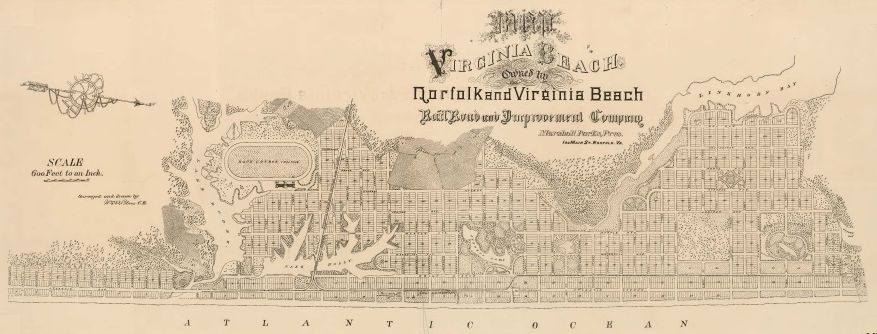
the railroad from Norfolk to Virginia Beach was built in 1883 to get tourists to the new resort at the oceanfront
Source: Library of Congress, Railway mail map of Virginia (Earl P. Hopkins, c.1910)

the railroad from Norfolk to Virginia Beach was built in 1883 to get tourists to the new resort at the oceanfront
Source: Library of Congress, Railway mail map of Virginia (Earl P. Hopkins, c.1910)
In 1875, the General Assembly chartered the Norfolk and Princess Anne Narrow Gauge Railway Company. It was unable to raise funds and soon went out of business, unable to implement its plan to build track to:1
Jonathan Mark Souther, "Twixt ocean and pines: the seaside resort at Virginia Beach, 1880-1930," University of Richmond Masters Thesis, May, 1996, pp.5-6, https://scholarship.richmond.edu/cgi/viewcontent.cgi?article=2046&context=masters-theses (last checked December 16, 2018)
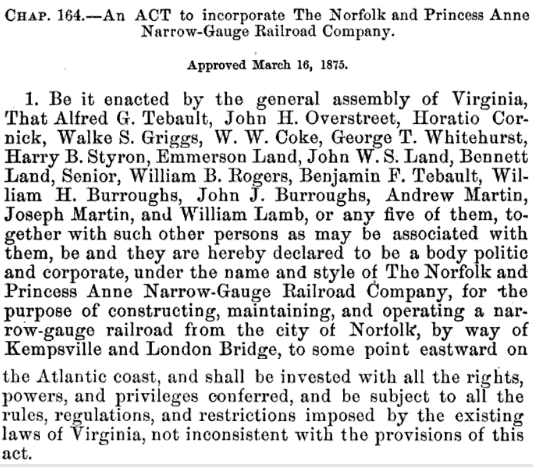
the Norfolk and Princess Anne Narrow Gauge Railway Company, chartered in 1875, was never built
Source: Acts and Joint Resolutions, Amending the Constitution, of the General Assembly of the State of Virginia (pp.163-164)
The Norfolk, Virginia Beach Railroad and Improvement Company built narrow-gauge track from Norfolk to the Alantic Ocean shoreline of Princess Anne County (now the City of Virginia Beach). It started general public service from Broad Creek to the ocean on July 28, 1883, and completed the Norfolk-Broad Creek link in 1884. The Norfolk, Virginia Beach Railroad and Improvement Company was necessary because the company was developing the "high order summer resort" that it named Virginia Beach.2
"Kicking Up A Stink In Virginia Beach," Out of the Box blog - Library of Virginia, http://www.virginiamemory.com/blogs/out_of_the_box/tag/norfolk-and-virginia-beach-railroad-and-improvement-company/; Jonathan Mark Souther, "Twixt ocean and pines: the seaside resort at Virginia Beach, 1880-1930," University of Richmond Masters Thesis, May, 1996, p.12, https://scholarship.richmond.edu/cgi/viewcontent.cgi?article=2046&context=masters-theses (last checked December 16, 2018)
The railroad carried both tourists to the developing resort area, plus agricultural products from the truck farms in the county. It was difficult to attract visitors from the industrialized Mid-Atlantic region who were able to spend time (and money) at the resort. There were 28 miles of beaches on the Atlantic Ocean and 10 miles of beaches on the Chesapeake Bay, but Atlantic City and "the springs" in the mountains were among the many stiff competitors.
Unlike Atlantic City, Virginia Beach lacked a major population center that would supply customers for the railroad and the resort area. The Norfolk, Virginia Beach and Southern Railroad was a financial failure and went through receivership (bankruptcy) in 1884-1885. By one assessment, Virginia Beach was:3
Jonathan Mark Souther, "Twixt ocean and pines: the seaside resort at Virginia Beach, 1880-1930," University of Richmond Masters Thesis, May, 1996, p.viii, p.15, https://scholarship.richmond.edu/cgi/viewcontent.cgi?article=2046&context=masters-theses; "A Beach Called Virginia," Washington Post, May 15, 1992, https://www.washingtonpost.com/archive/lifestyle/1992/05/15/a-beach-called-virginia/51138823-0f86-4aec-a749-a65a96a24a1c/ (last checked December 12, 2018)
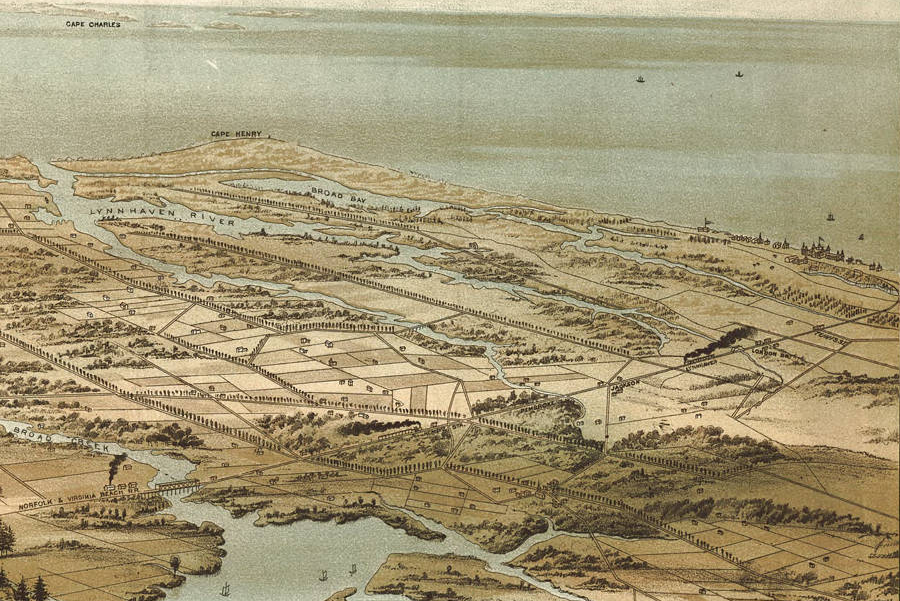
the Norfolk and Virginia Beach Railroad crossed an agricultural Princess Anne County in 1892, on the way to the Atlantic Ocean shoreline
Source: Norfolk Public Library, Panorama of Norfolk and Surroundings, 1892
Expenses exceeded revenues again, and the corporation went through another receivership in 1887. After emerging, the rail line was renamed the Norfolk and Virginia Beach Railroad. The Virginia Beach Hotel was renamed the Princess Anne Hotel.
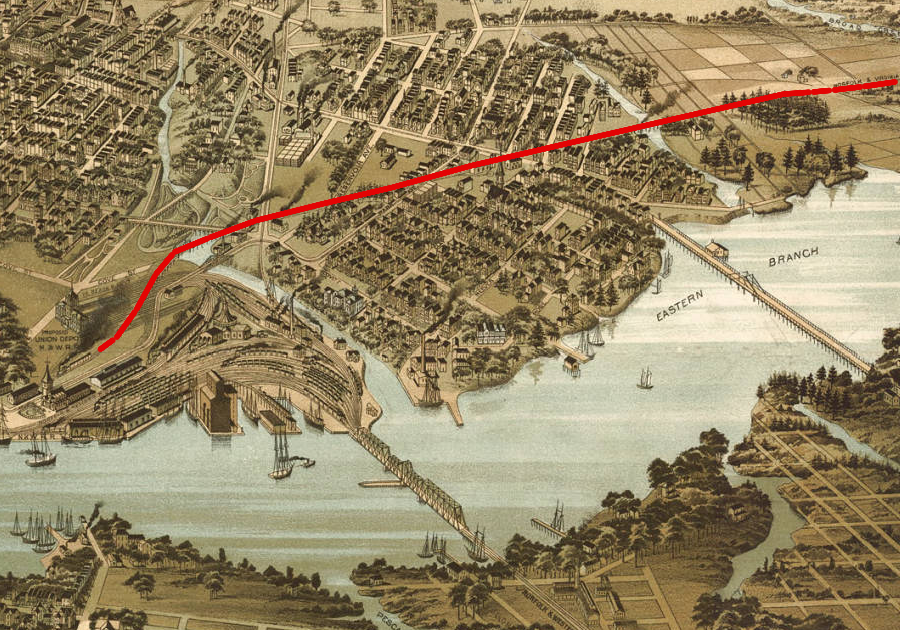
the Norfolk and Virginia Beach Railroad carried passengers from what is today's Harbour Park eastward to the Atlantic Ocean
Source: Norfolk Public Library, Panorama of Norfolk and Surroundings, 1892
In 1891, the railroad was renamed again.
The old charter limited the railroad to just narrow gauge, so the investors purchased the stock of a "paper railroad" chartered as the Danville and Seaboard. It had authorization from the General Assembly to build a standard gauge line, but no potential of finding funding to construct any track. The Norfolk and Virginia Beach Railroad and the "paper" Danville and Seaboard Railroad were consolidated into the Norfolk, Albermarle & Atlantic Railroad.
The planned conversion to standard gauge would allow interchange of passenger cars with the Norfolk and Western Railroad. Tourists recruited from outside the Norfolk area would not longer have to get out of the Norfolk and Western's standard gauge cars at its station in Norfolk, then transfer with their luggage to narrow gauge cars on the former Norfolk and Virginia Beach Railroad in order to complete their journey to a beach vacation.
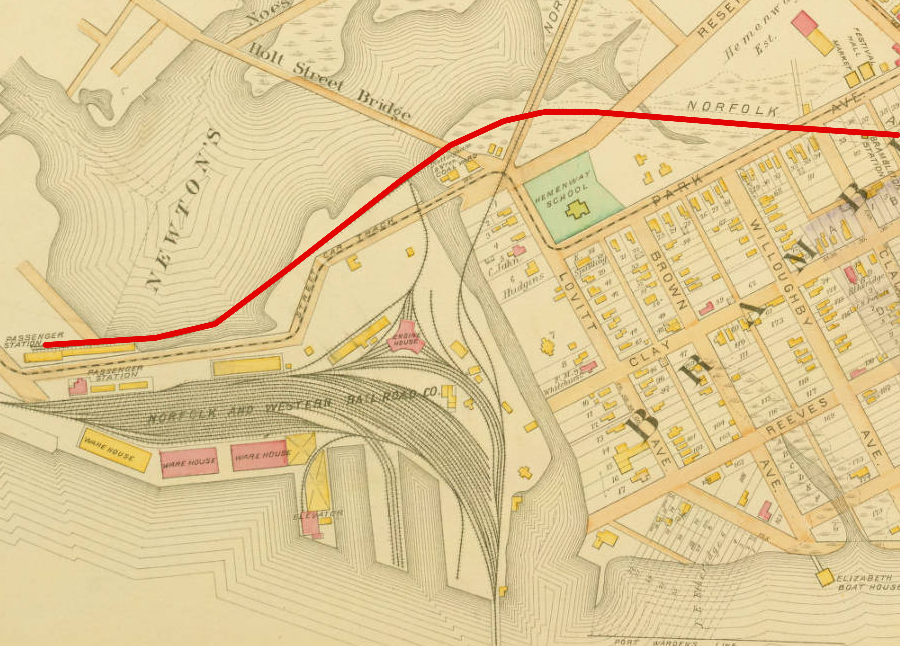
the Norfolk and Virginia Beach Railroad station was next to the Norfolk and Western Station, now the Amtrak station at Harbor Park
Source: Norfolk Public Library, Atlas of the city of Norfolk, Va. and vicinity, including the city of Portsmouth (1889)
The Norfolk, Albermarle & Atlantic Railroad also planned for an extension south to Mackey's Island in North Carolina, and north to Cape Henry. Once again, however, it failed to generate enough income to pay its debts. The receivership which began in 1893 was extended due to the "panic" (business recession) which began that year.
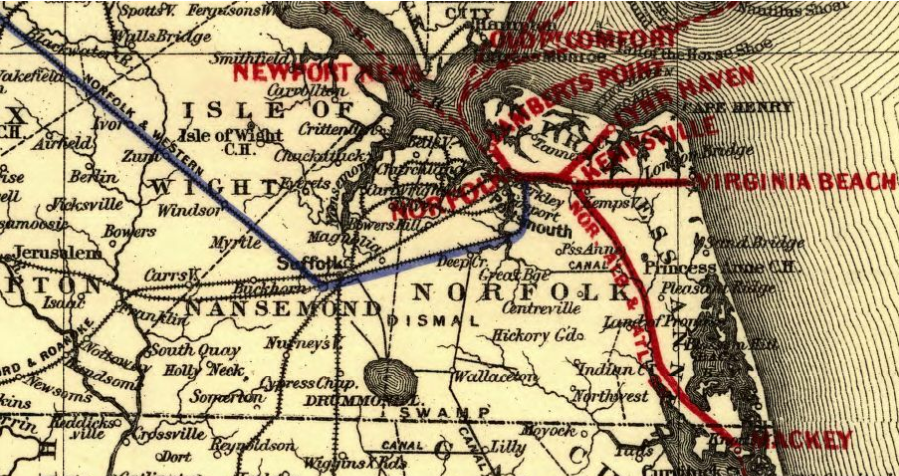
the Norfolk, Albermarle & Atlantic Railroad name was used from 1891-1896
Source: Library of Congress, Maps showing the Norfolk, Albermarle & Atlantic Railroad and its connections (G.W. & C.B. Colton & Co, 1891)
In contrast to the struggling hotels on the Atlantic Ocean shoreline that were reached via the Norfolk, Albermarle & Atlantic Railroad, the Ocean View resort area on the Chesapeake Bay near Willoughby Spit was generating steady traffic. Tourists were being transported from Norfolk to Ocean View by the rival Norfolk and Ocean View Railroad.
The Norfolk and Ocean View Railroad had been built as a narrow gauge line in 1878, then converted in 1894 to standard gauge and electrified. The "trolleys" of the Norfolk and Ocean View Railroad brought a steady stream of visitors north to Ocean View Amusement Park and the cottages along the Chesapeake Bay waterfront.
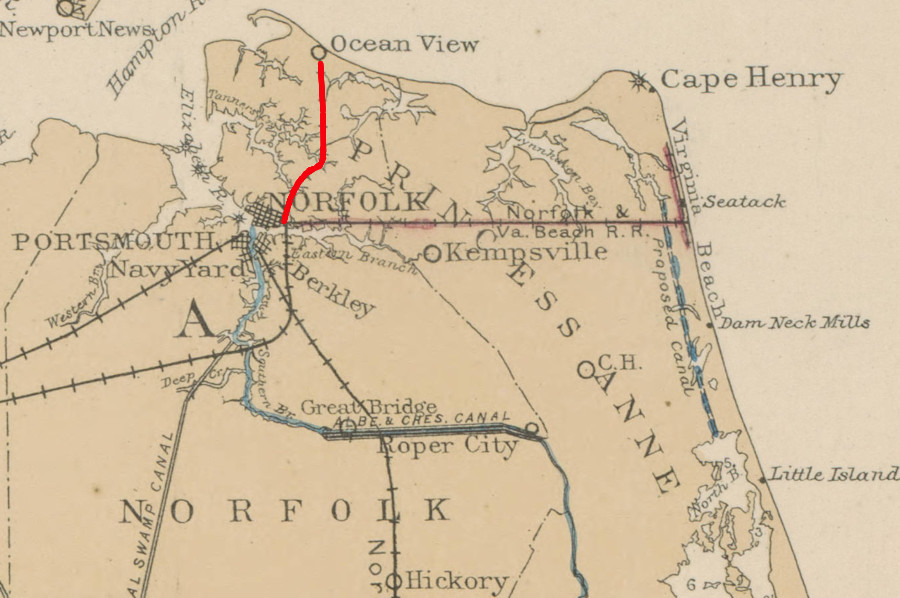
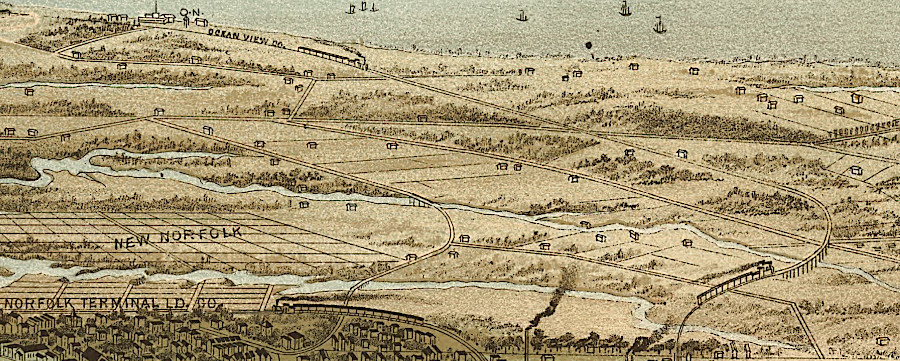
the Norfolk and Ocean View Railroad (red line) carried tourists to an alternative waterfront resort area - Ocean View on the Chesapeake Bay
Source: University of North Carolina, Map of the Albemarle and Chesapeake Canal: connecting Chesapeake Bay with Currituck, Albemarle and Pamplico sounds and their tributary streams (by A. Lindenkohl and Henry Lindenkohl, 1885); Library of Congress, Panorama of Norfolk and surroundings 1892
In 1896, the Vanderbilt family purchased the Norfolk, Albermarle & Atlantic Railroad at public auction and renamed it the Norfolk, Virginia Beach & Southern Railroad. With the resources of the Vanderbilts, the track was finally converted to standard gauge in 1897.4
"Historic Railroad Map of North Carolina & Virginia - 1891," World Maps Online, https://www.worldmapsonline.com/historicalmaps/1W-NC-RR-1891.htm; Jonathan Mark Souther, "Twixt ocean and pines: the seaside resort at Virginia Beach, 1880-1930," University of Richmond Masters Thesis, May, 1996, p.17, p.19, pp.26-27, pp.33-34, https://scholarship.richmond.edu/cgi/viewcontent.cgi?article=2046&context=masters-theses; Amy Waters Yarsinske, Ocean View, Arcadia Publishing, 1998, p.18, https://books.google.com/books?id=HRLCxKsMSK0C (last checked December 16, 2018)
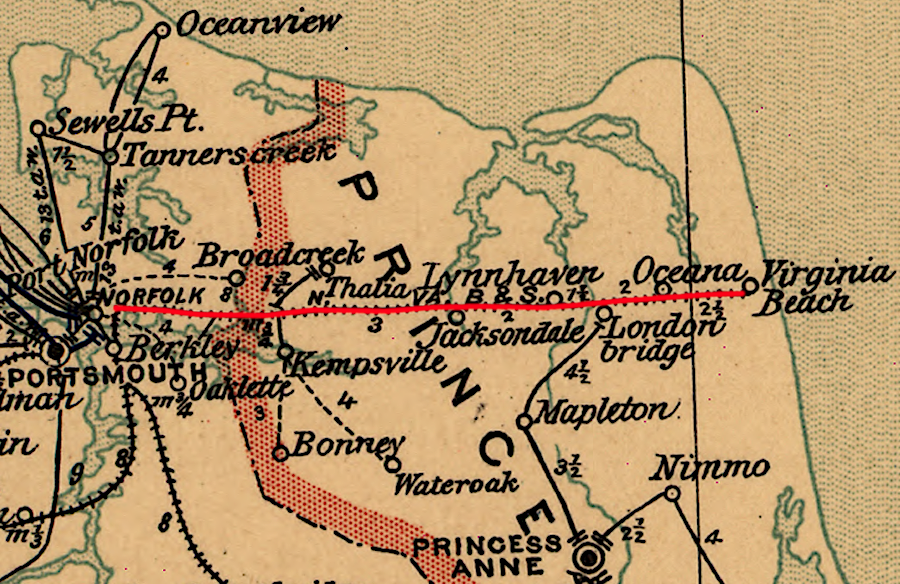
the Norfolk, Virginia Beach & Southern Railroad in 1896, two years before constructing a line to Munden
Source: Library of Congress, Post route map of the state of Virginia and West Virginia (1896)
In 1898, the Norfolk, Virginia Beach & Southern Railroad built a branch south to Munden. The Munden Point branch passed through truck farms south of the courthouse and around Pungo. Farms in northeastern North Carolina used steamships to carry produce to Munden Point for transport north by rail to buyers in Norfolk. The modern Munden Point Park, opened in 1982, is at the site of the old pier.5 "Norfolk to Virginia Beach and Munden," AbandonedRails.com, http://www.abandonedrails.com/Norfolk_to_Virginia_Beach_and_Munden; "Looking back | Rail service in Virginia Beach," The Virginian-Pilot, November 4, 2015, https://pilotonline.com/news/article_a4130d19-a99b-58de-8feb-a40ad9b15cad.html; "Railroad once connected downtown Norfolk to remote hunting grounds of what is now Virginia Beach," The Virginian-Pilot, April 22, 2017, https://pilotonline.com/news/local/history/article_703603af-1ee4-5f56-9b83-b2b1b3e3ebd9.html (last checked December 3, 2018)
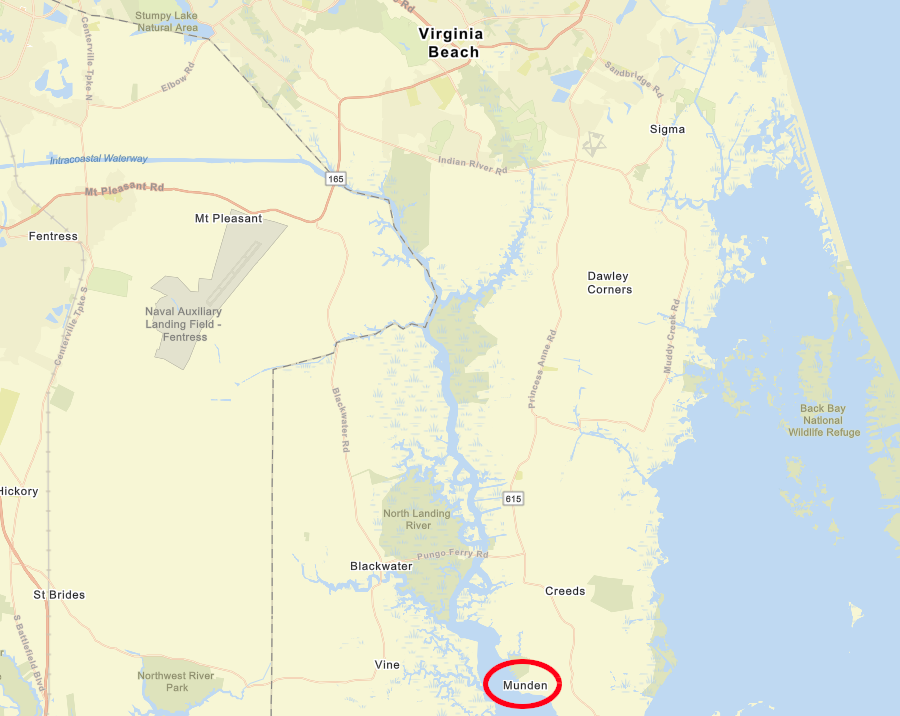
the Norfolk, Virginia Beach & Southern Railroad built a branch south to Munden in 1898
Source: ESRI, ArcGIS Online
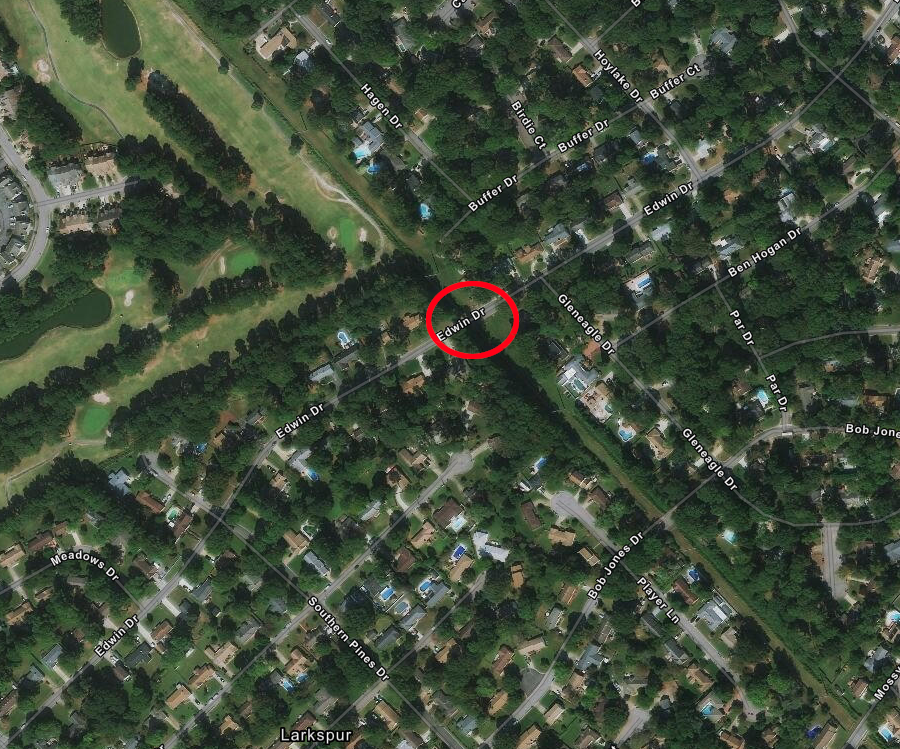
a green swath shows where the Munden Branch crosssed Edwin Drive near Kempsville Greens Golf Course in Virginia Beach
Source: ESRI, ArcGIS Online
The original Norfolk Southern Railroad acquired the Norfolk, Virginia Beach and Southern Railroad in 1899. That purchase brought an end to the Norfolk, Virginia Beach and Southern Railroad; it was merged into the original Norfolk Southern Railroad. That company was merged into the modern Norfolk Southern Railroad in 1982.
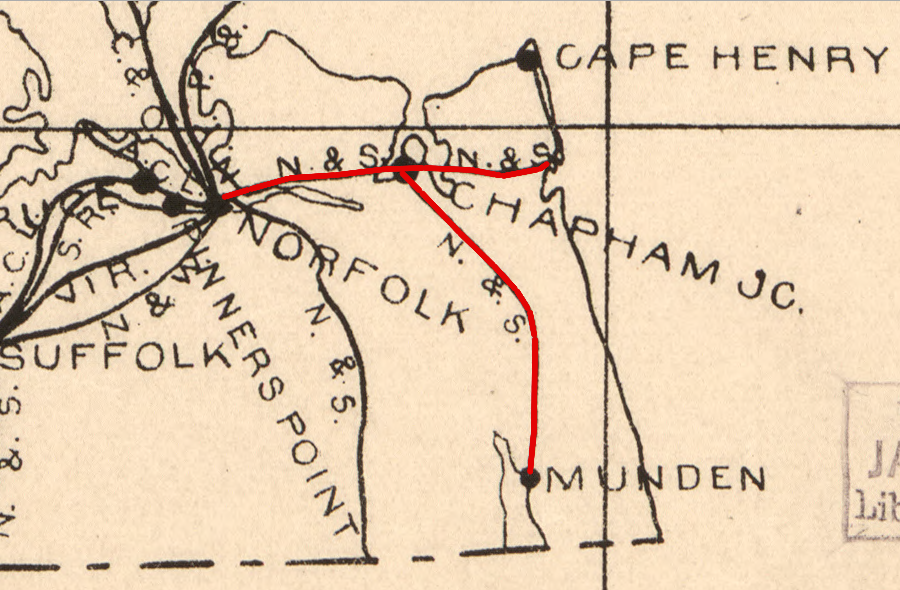
red line marks the Norfolk, Virginia Beach and Southern Railroad track acquired by Norfolk Southern in 1900, including the Munden Branch
Source: Library of Congress, Railway mail map of Virginia (Earl P. Hopkins, c.1910)
In 1947 the original Norfolk Southern stopped passenger service on the route between Norfolk and the oceanfront resort area of Virginia Beach, on the roadbed which the Norfolk, Virginia Beach Railroad and Improvement Company had constructed in 1884. All freight service ended in 2002.6
Norfolk Light Rail Transit Project, Hampton Roads Transit: Environmental Impact Statement, Federal Transit Administration and Hampton Roads Trnsit, 2005, p.4-8, https://books.google.com/books?id=5yA3AQAAMAAJ; "Memories of rail trestles in Virginia Beach," The Virginian-Pilot, April 30, 2015, https://www.pilotonline.com/news/article_e103fcea-1c4a-5e2d-865a-6fd630e83a16.html; "Annual Report of the State Corporation Commission of Virginia. Compilations from Returns of Railroads, Canals, Electric Railways and Other Corporate Companies," Virginia State Corporation Commission, 1917, p.303, https://books.google.com/books?id=BN8lAQAAIAAJ (last checked June 30, 2020)
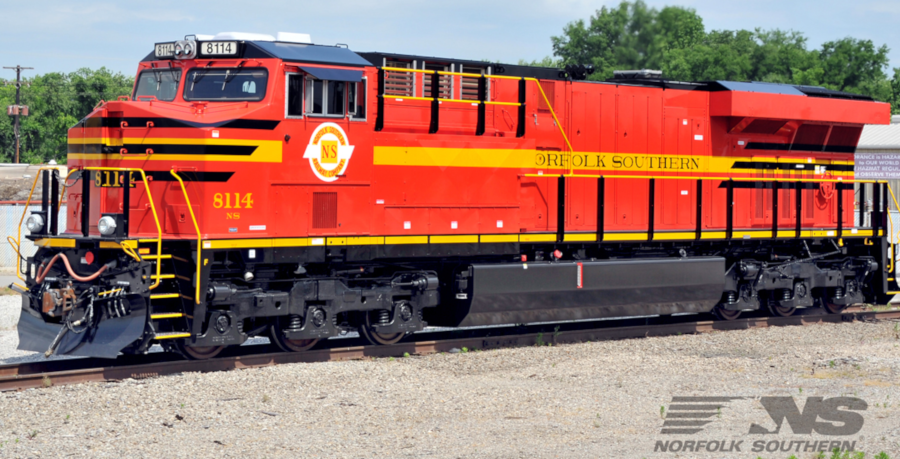
the modern Norfolk Southern painted locomotives of its predecessor railroads in 2012 to honor its 30th anniversary
Source: Norfolk Southern, Our Colorful Heritage
The modern Norfolk Southern negotiated for years with the cities of Norfolk and Virginia Beach to sell the old Norfolk, Virginia Beach and Southern right-of-way. The two cities intended to use it as the route of a light rail line, essentially replicating the electrified portion of the original Norfolk Souhern Railroad that had carried passengers to the oceanfront until 1947 and freight until 2002.
Virginia Beach voters rejected the light rail proposal in 1999, but Norfolk proceeded to build The Tide transit system within its boundaries. Despite the voter rejection, the Virginia Beach City Council revived the proposal to extend the light rail system, planning for it first to support Transit-Oriented Development at Town Center.
In the long term, city planners envisioned recreating a passenger connection by rail between Norfolk and the oceanfront of Virginia Beach. Tourists could come by Amtrak to Norfolk, and catch The Tide to the hotels along the Atlantic Ocean shoreline.
The state of Virginia provided $20 million for purchase of the old railroad right-of-way, and the city contributed another $20 million to complete the purchase. The plans died in 2016, when Virginia Beach voters again rejected the light rail project. That vote blocked extension of The Tide along the old Norfolk Southern right-of-way to Town Center, and later the Oceanfront.
After the vote, the city sought permission from the state to retain the $20 million used to purchase the right-of-way and create pedestrian or bike trail. State officials made clear that the funding was for a transit system, so the city repaid the state its $20 million share of acquisition costs in 2017.7 "Original Norfolk Southern Railway, 'East Carolina Dispatch'," American-Rails.com, https://www.american-rails.com/original-norfolk-southern-railway.html; "Light rail in Virginia Beach failed. Here's what happens next," The Virginian-Pilot, November 9, 2016, https://pilotonline.com/news/local/transportation/article_63c21801-1388-541a-821e-0309c932b2ca.html; "Life after light rail: Virginia Beach owes the Commonwealth $20 million," WAVY, January 23, 2017, https://www.wavy.com/news/life-after-light-rail-virginia-beach-owes-the-commonwealth-20-million_20180320062402855/1061091620; "Virginia Beach City Council votes to pay back $20 million loan for light rail," The Virginian-Pilot, March 21, 2017, https://pilotonline.com/news/government/local/article_8154306e-8703-5223-81cd-3946c97d90cd.html (last checked December 3, 2018)
Today, the right-of-way sits unused east of the Tide's Newtown Station. City officials consider it a "connectivity corridor" for future fiber optic lines, overhead utilities, bike/pedestrian trail, and other possibilities.
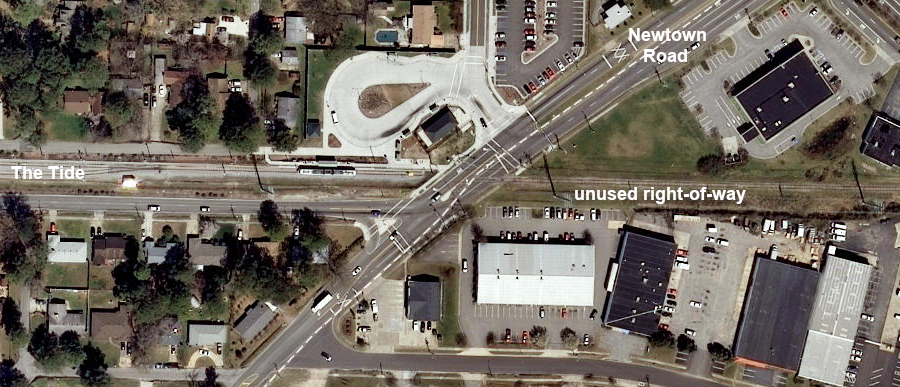
The Tide ends at Newtown Road, and the old Norfolk and Virginia Beach/Norfolk Southern Railroad right-of-way remains unused east of that point
Source: ESRI, ArcGIS Online
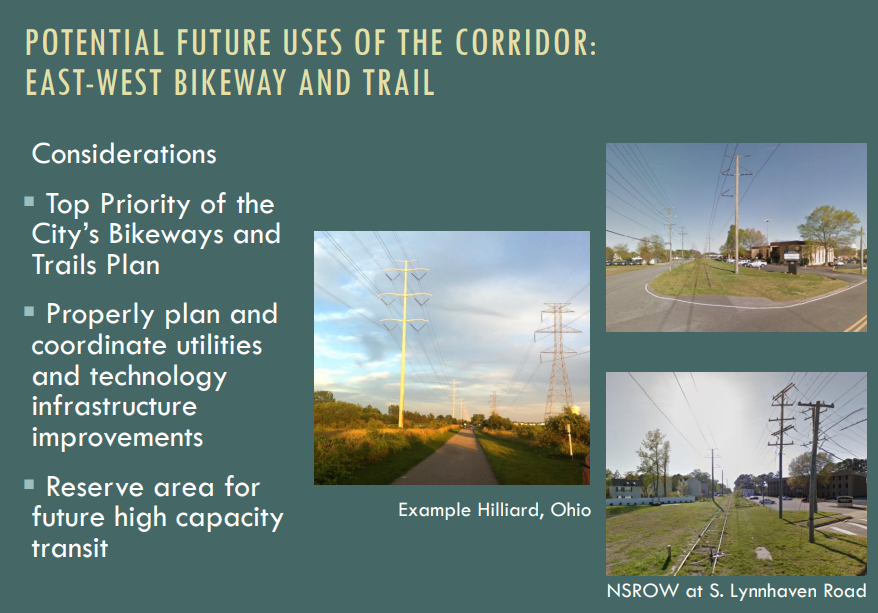
the route used in 1884 by the Norfolk, Virginia Beach Railroad and Improvement Company is still a connectivity corridor in Virginia Beach
Source: City of Virginia Beach, Public Transportation Strategy Briefing (January 2017)
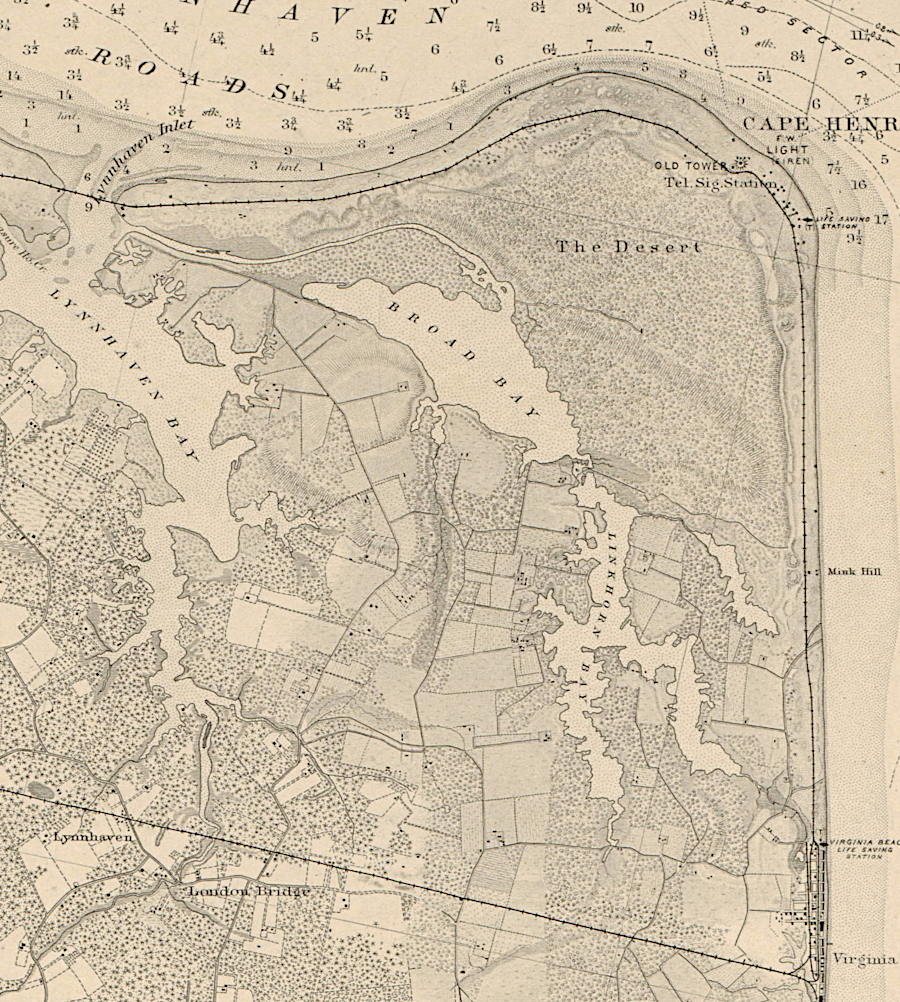
passengers on the original Norfolk Southern could take a loop from Norfolk to Cape Henry, then to Virginia Beach and back to Norfolk
Source: University of North Carolina, From Cape Henry to Currituck Beach, including the Albemarle and Chesapeake Canal (US Coast and Geodetic Survey, 1906)
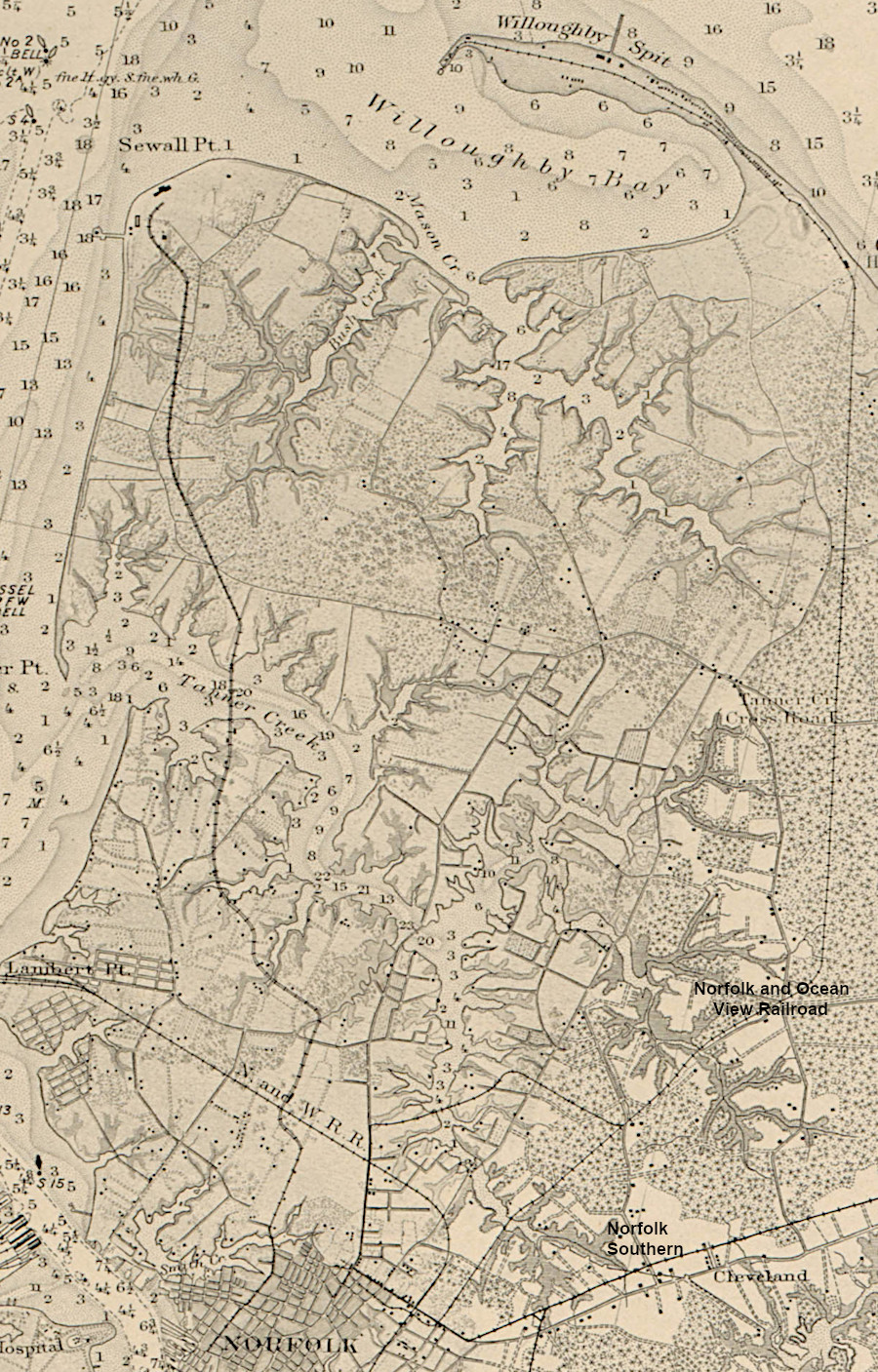
the Norfolk and Ocean View Railroad linked downtown Norfolk with the Chesapeake Bay resort area on Willoughby Spit
Source: University of North Carolina, From Cape Henry to Currituck Beach, including the Albemarle and Chesapeake Canal (US Coast and Geodetic Survey, 1906)